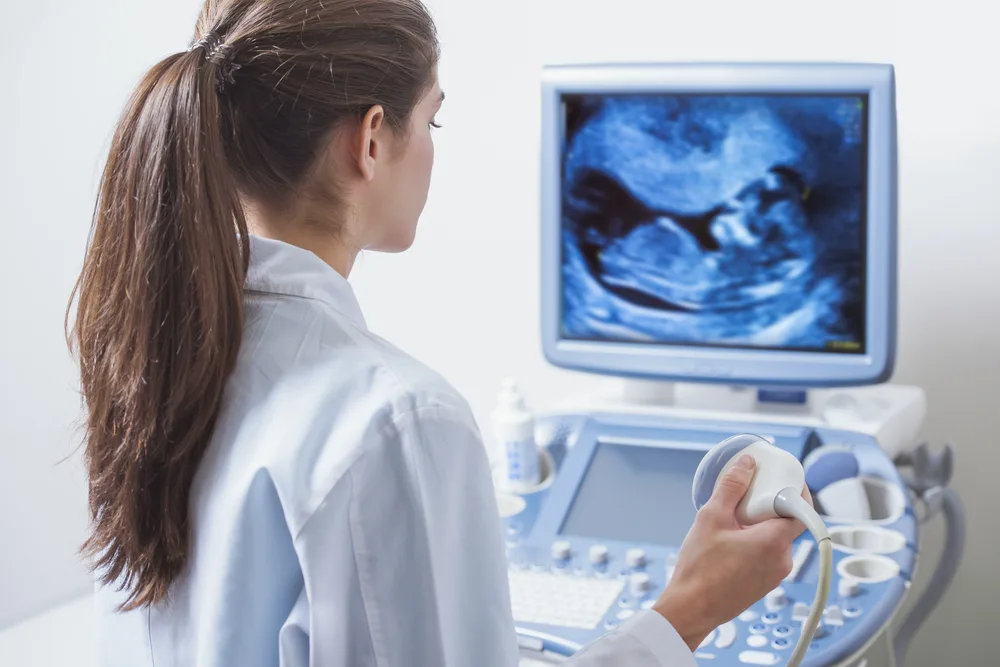Jump to:
If you’re expecting a little one, you might have seen hair on an ultrasound. But is that really what you are seeing, or are your eyes deceiving you? We’ll debunk this age-old question below.
Can You See Hair on an Ultrasound?
If you or your partner is pregnant and goes to the ultrasound technician to get a checkup on your future baby, depending on the baby’s age in utero, you will be able to see some hair. This hair is lanugo and shows up at about 28 weeks of gestation.
What Exactly Is an Ultrasound?
An ultrasound is a picture created by using sound waves. It’s also called a sonogram. Medical professionals use this method to see structures within your body and it’s most commonly associated with pregnancy.
However, ultrasounds are also used to inspect for breast cancer, tumors, cysts, or other abnormalities.
Ultrasounds are an essential medical technology because they allow external examination and diagnosis. Some ultrasounds require placing a small bit of machinery inside your body, but the vast majority happen externally only.
Seeing Your Baby’s Hair on an Ultrasound
Although you may see some fuzzy white strands of hair on your baby’s head at around seven months of pregnancy, your baby will likely lose this lanugo before birth.
The reason in utero hair (lanugo) develops is to keep the baby warm, and around 30 to 32 weeks of gestation, just eight weeks away from your due date, your baby can lose that hair. This is because they’re gaining body fat, so they no longer need that wispy, downy soft lanugo.
Some babies will retain that head of hair when they’re born, but it quickly falls out after a few weeks or months, replaced by downy peach fuzz and eventually their regular hair.
Keep in mind that whether your baby has lanugo on the ultrasound, is bald on their head, comes out of the womb with hair, and/or loses their hair soon after being born, they won’t even have the hair they will likely acquire later in life until they’re about two years old.
This is why so many people who have grown up with dark hair may have had blond hair as a child or vice versa. It takes about two years for what’s called terminal hair to grow in, so your baby’s hair will likely keep surprising you, just like it did when you were pregnant.
Other Uses for Ultrasounds
Ultrasounds are excellent tools for taking pictures of the inside of the body, especially parts that do not show up well on x-rays, which is why they’re used during pregnancy; x-rays are potentially harmful to babies in the womb and pregnant mothers.
When a patient may have cancer or some other abnormal cell growth, ultrasounds are indispensable when externally examining whatever problem has arisen.
Once a problem area is apparent, such as a strange growth or mass, the doctor can take a biopsy using a long needle so that the procedure remains as external as possible rather than invasive. Some tumors and cysts can grow hair on the inside.
Since hair shows up on an ultrasound, this can help diagnose certain (rare) medical conditions. Hair makes different echo patterns from fluid and other soft tissues, so this is invaluable information when making a diagnosis.
The main use of ultrasound in this case is to find the affected area so that a doctor can perform a biopsy for further tests. The best part about ultrasounds is that they do not use radiation to protect the patients and doctors from x-rays while they use this equipment.
Hair on an Ultrasound FAQs

Thomas Andreas/Shutterstock
Still have questions about hair on an ultrasound? Read on for answers to the most common!
When does your baby start to grow any sort of visible hair?
You can start to see small facial hairs in the womb on an ultrasound at about halfway through pregnancy (20 weeks). However, your baby does not likely have lanugo yet at this stage.
Why do babies have lanugo?
About one-third of babies are born with this hair called lanugo. They develop it inside the womb to keep warm and regulate their body temperature. Many babies lose the hair they’re born with soon after birth.
What are the risks for me and my baby of having an ultrasound?
There are no risks associated with having an ultrasound. It generates the pictures using low-frequency sound waves, and these simply bounce off your body to form pictures generated on a monitor.
Can I see my baby’s hair on a 3D ultrasound?
If your baby has hair in the womb, it won’t show up on a 3D ultrasound as it will on a traditional 2D ultrasound. If your baby has enough hair, it will likely present as contours on your baby’s head.
If my baby is hairy in the womb, will that cause me heartburn?
This is just a myth, don’t worry. There might be a connection, but that doesn’t necessarily mean causation; it’s just as likely that the foods you’re consuming for the two of you have promoted your baby’s fetal hair growth just as much as it’s causing your heartburn.
So, Can You See Hair on an Ultrasound?
Short answer: yes, you can see hair on an ultrasound. The hair you see on is lanugo and appears at about 28 weeks. However, your baby will likely lose the lanugo before birth. Now, take a moment to enjoy this experience. It’s a memory that’ll last a lifetime!
